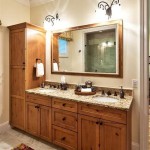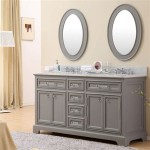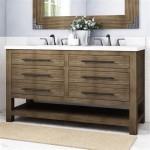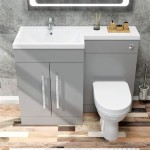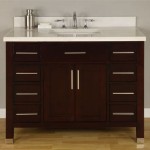Corner Bathroom Vanities with Tops: Maximizing Space and Style
Corner bathroom vanities with tops represent a practical and aesthetically pleasing solution for bathrooms where space is limited. These vanities are designed to fit neatly into the corner of a room, utilizing an otherwise often-unused area. The inclusion of a top, usually a countertop, provides a functional surface for toiletries and other bathroom necessities, streamlining the design and eliminating the need for a separate sink installation. This article will explore the various aspects of corner bathroom vanities with tops, including their benefits, types, considerations for selection, and installation guidelines.
The core advantage of a corner vanity lies in its efficient use of space. In smaller bathrooms, every square inch counts. Traditional vanities can occupy significant wall space, potentially making the room feel cramped. A corner vanity, by contrast, fits snugly into the corner, freeing up floor space and creating a more open and airy feel. This is particularly beneficial in older homes or apartments where bathroom dimensions are often smaller than those found in modern construction.
Furthermore, corner vanities are available in diverse styles and finishes, allowing homeowners to match the vanity to their existing bathroom décor. From classic designs with ornate detailing to contemporary styles with clean lines and minimalist aesthetics, there is a corner vanity to suit almost every taste. The countertop material also offers a wide range of options, including granite, marble, quartz, ceramic, and solid surface materials. Each material offers a different combination of durability, aesthetics, and price point, allowing for further customization.
Space Optimization and Ergonomics
One of the primary reasons for choosing a corner bathroom vanity is its ability to optimize space. Traditional vanities often require a significant amount of wall space, which can be problematic in smaller bathrooms. Corner vanities, on the other hand, are designed to fit neatly into the corner of the room, effectively utilizing what would otherwise be wasted space. This can be particularly beneficial in bathrooms with unconventional layouts or limited square footage.
The corner placement also contributes to improved traffic flow within the bathroom. By concentrating the vanity into a corner, it frees up more floor space, making it easier to move around the room without feeling cramped. This is especially important in shared bathrooms or bathrooms where multiple people are using the space simultaneously.
Beyond space optimization, corner vanities can also offer ergonomic benefits. The placement of the sink in the corner can sometimes provide a more natural and comfortable posture for users, especially children or individuals with mobility issues. While this is not always the case, it is a factor to consider when selecting a vanity, as the overall comfort and usability of the bathroom space are paramount.
The design of the interior cabinet space also plays a key role in space optimization. Corner vanities often feature unique storage solutions, such as rotating shelves or pull-out drawers, that maximize the use of the available space. These features can help to keep toiletries and other bathroom essentials organized and easily accessible, further enhancing the functionality of the vanity.
Material Selection and Durability
The selection of materials for both the vanity cabinet and the countertop is a critical factor in determining the overall durability, longevity, and aesthetic appeal of the corner bathroom vanity. The cabinet material should be chosen based on its resistance to moisture, as bathrooms are inherently humid environments. Common materials for vanity cabinets include solid wood, plywood, MDF (medium-density fiberboard), and PVC (polyvinyl chloride). Solid wood is generally considered the most durable option, but it can also be the most expensive. Plywood is a good compromise, offering a combination of durability and affordability. MDF is a more affordable option, but it is more susceptible to moisture damage and should be properly sealed. PVC is a completely waterproof option, but it may not offer the same aesthetic appeal as wood or plywood.
The countertop material also plays a significant role in the vanity's durability and aesthetics. Granite and quartz are popular choices due to their durability, resistance to scratches and stains, and elegant appearance. Marble is another luxurious option, but it is more porous and requires more maintenance. Ceramic tile is a cost-effective option that is also durable and easy to clean. Solid surface materials, such as Corian, offer a seamless and non-porous surface that is resistant to stains and scratches. The best countertop material will depend on the homeowner's budget, design preferences, and lifestyle.
The hardware used in the vanity, such as the hinges, drawer slides, and handles, also contributes to its overall durability and functionality. High-quality hardware will ensure that the drawers and doors open and close smoothly and that the vanity will withstand daily use for many years to come. It is generally advisable to invest in hardware made from durable materials, such as stainless steel or brass.
Proper sealing and finishing are also essential for protecting the vanity from moisture damage. The cabinet should be sealed with a water-resistant sealant, and the countertop should be finished with a protective coating to prevent stains and water damage. Regular cleaning and maintenance will also help to prolong the life of the vanity and keep it looking its best.
Style and Design Considerations
Corner bathroom vanities are available in a wide range of styles and designs, allowing homeowners to choose a vanity that complements their existing bathroom décor. From traditional to contemporary, there is a corner vanity to suit almost every taste. Traditional vanities often feature ornate detailing, such as raised panel doors, decorative moldings, and antique-style hardware. These vanities are typically made from solid wood and finished with a rich stain or paint.
Contemporary vanities, on the other hand, tend to feature clean lines, minimalist aesthetics, and sleek hardware. These vanities are often made from MDF or plywood and finished with a glossy paint or laminate. Some contemporary vanities also incorporate glass or metal accents. Floating vanities, which are mounted to the wall and do not have legs, are a popular choice for contemporary bathrooms.
The choice of countertop material can also significantly impact the overall style of the vanity. Granite and marble countertops tend to lend a more elegant and luxurious look, while solid surface countertops offer a more modern and minimalist aesthetic. The color and pattern of the countertop should also be carefully considered to complement the cabinet finish and the overall color scheme of the bathroom.
The size and shape of the sink are also important design considerations. Corner vanities are typically designed to accommodate either a single sink or a double sink. A single sink is a more common choice for smaller bathrooms, while a double sink is a better option for larger bathrooms or shared bathrooms. The shape of the sink can also vary, with options including rectangular, oval, and round sinks. The choice of sink shape will depend on the homeowner's personal preferences and the overall style of the bathroom.
Lighting is another key design element to consider when selecting a corner bathroom vanity. Proper lighting can enhance the functionality and aesthetics of the vanity. Vanity lights should be positioned to provide adequate illumination for grooming and other tasks. Options include sconces, LED strip lights, and recessed lighting. The color temperature of the lighting should also be considered, as warm lighting can create a more relaxing atmosphere, while cool lighting can provide better visibility.
Finally, the overall layout of the bathroom should be taken into consideration when selecting a corner vanity. The placement of the vanity should be such that it does not obstruct traffic flow or interfere with other fixtures in the bathroom. It is also important to ensure that there is adequate space for opening drawers and doors.

Home Decorators Collection Aberdeen 32 In Single Sink Corner White Bath Vanity With Carrara Marble Top Assembled 32w The

Miscool Anky 12 8 In W X D 22 H Single Sink Corner Bath Vanity Navy Blue With White Ceramic Top

24 Inch Triadsville White Corner Bathroom Vanity With Sink Top Tennant Brand

Home Decorators Collection Hamilton 31 In W X 22 D 35 H Single Sink Freestanding Bath Vanity Ivory With Gray Granite Top 10809 Cs30h Dw The

13 Inch Plywood Corner Wall Mounted Bathroom Vanity With Top Integrated Ceramic Sink Soft Close Door In Navy Blue

24 Inch Triadsville Teal Blue Corner Bathroom Vanity Tennant Brand

Benton Collection Thomasville 24 In W X D 34 5 H Corner Bath Vanity White With Black Granite Top And Porcelain Sink

Corner Single Sink Bathroom Vanities With Tops At Com

Traditional Corner Bathroom Vanities With Tops At Com

Corner Sink Vanity Bathroom Cabinet
